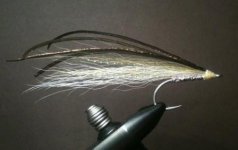Do not go overboard tying flies, especially since this is your first time. If you want to tie a few I would suggest a white Lefty's Deceiver four and six inches long, a chartreuse/white or olive/white clouser minnow three and five inches long, and a few plain old sparsely tied bucktails in mixtures of white, yellow and olive (maybe a little red mixed in) from three inches to as long as possible (yes, like a Mickey Finn or Black Nose Dace trout streamer). Do not underestimate the effectiveness of the bucktail flies. Of the three flies I noted, if I had to pick one it would be the bucktail pattern.
Tie all of these on a 2/0 wide gap tin plated hook. I personally prefer Gamakatsu SC15. Buy one pack (ten hooks) and you can tie everything above. If you need dumbbell eyes for the clouser buy a pack of medium plated eyes.
If you need any other fly, buy them at a local store.
Final advice, striper fly fishing is all about presentation and not so much fly selection.




